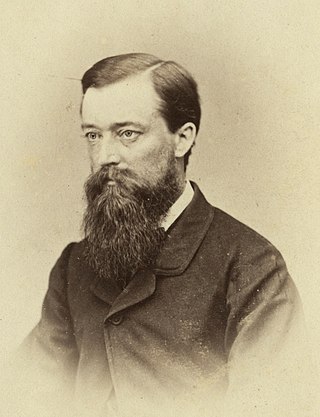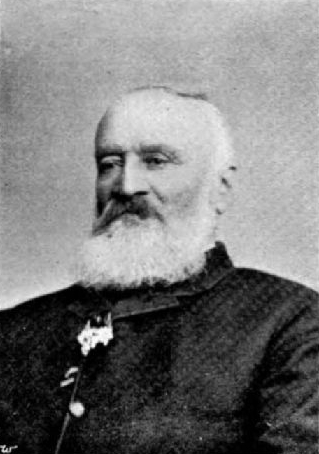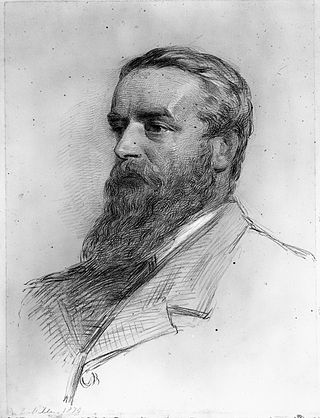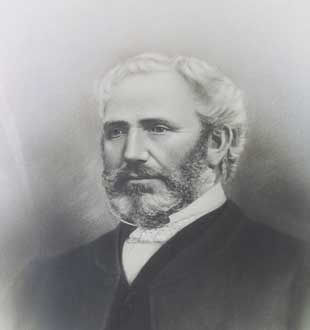
Erewhon: or, Over the Range is a novel by English writer Samuel Butler, first published anonymously in 1872, set in a fictional country discovered and explored by the protagonist. The book is a satire on Victorian society.
James Frederick Stuart-Wortley JP was a politician in New Zealand and the UK. He was New Zealand's inaugural Baby of the House and remains the youngest member of parliament in the country's history; in fact he was too young to even be legally elected.

The Rangitata River is one of the braided rivers of the Canterbury Plains in southern New Zealand. It flows southeast for 120 kilometres (75 mi) from the Southern Alps, entering the Pacific Ocean 30 kilometres (19 mi) northeast of Timaru. The river has a catchment area of 1,773 square kilometres (685 sq mi), and a mean annual flow of 95 cubic metres per second (3,400 cu ft/s) at Klondyke.

Crosbie Ward was a 19th-century member of parliament in New Zealand.

Isaac Thomas Cookson was a 19th-century Member of Parliament in Canterbury, New Zealand. He was a prominent merchant in early Canterbury.
Alfred Richard Creyke JP was a 19th-century Member of Parliament in Canterbury, New Zealand. He was a significant landholder in Canterbury. Of English descent, he spent just over ten years in the colony before returning home.
John Charles Watts-Russell JP was a 19th-century New Zealand politician, a member of the Canterbury Provincial Council and a member of the Legislative Council. He was supposedly the wealthiest of the early settlers, and his homestead became the centre of entertainment in Christchurch. He was a significant runholder and, together with a business partner, was responsible for building up the Canterbury sheep stock.
Thomas Rowley was an early settler in Canterbury, New Zealand. His father was a member of the Canterbury Association and Dean-designate for ChristChurch Cathedral, but never came to the colony. Thomas Rowley and one brother emigrated, and he became a significant runholder. He later started acting as an agent for absentee landowners. He briefly served as a Member of Parliament for one of the rural Canterbury electorates. Rowley was active in church matters and married a daughter of Octavius Mathias, the first vicar of the Church of St Michael and All Angels. After 11 years in New Zealand, he returned to live in England.

Alfred Cox was a 19th-century runholder and Member of the New Zealand House of Representatives. Born in New South Wales into an upper middle class military family, he was sent home to England to learn about farming. Upon returning to New South Wales, he heard about the large profits that were possible in South Canterbury and bought licences for land that he had not seen. He stocked the land, put a manager in charge and made another trip to England with his wife and their, at that time, small family. He moved to New Zealand permanently in 1857 and lived on his large farm, Raukapuka, which stretched from the sea to the foothills, and of which the homestead was located in present-day Geraldine. He sold his South Canterbury interests and moved to the Waikato, where he bought large land holdings in Hamilton and Thames. He tried to drain his swamp land and lost a lot of money with those ventures. He sold up in 1882 and moved to Christchurch, where he retired.
Joseph Sutton Beswick was a 19th-century politician and a magistrate in Canterbury, New Zealand. Of entrepreneurial spirit, he was involved with various rural sheep stations and involved in business dealings with John Hall. He and three of his brothers had emigrated to New Zealand from Yorkshire in 1853. Beswick was involved in politics at the local, provincial, and national level. He represented the Kaiapoi electorate for one year in the House of Representatives.

John Barton Arundel Acland, often referred to as J. B. A. Acland, was born in Devon, England, as the youngest child of Sir Thomas Dyke Acland, 10th Baronet. He followed his father's path of education and became a barrister in London. With his colleague and friend Charles George Tripp, he formed the plan to emigrate to Canterbury, New Zealand, to take up sheep farming. They were the first to take up land in the Canterbury high country for this purpose. When they divided their land into separate holdings, Acland kept the 100,000 acres (400 km2) that made up the Mount Peel station.

Charles George Tripp was a pioneering sheep farmer in South Canterbury, New Zealand. Together with his friend and business partner John Acland, he was the first to use the Canterbury high country for sheep farming.

Allan McLean was a New Zealand runholder and philanthropist. Moving from Scotland to Australia as a child, and to New Zealand as an adult, he rose from a working class shepherd, to sheep rancher and a rich land holder. In his seventies, McLean built 'Holly Lea' in Christchurch, which was renamed McLean's Mansion. After his death, the building served as the McLean Institute through an act of parliament.
Thomas Henry Wigley was a runholder in New Zealand. Born in England, he came to New Zealand via Australia in 1860. He was a member of the Nelson Provincial Council (1867–1869) and the New Zealand Legislative Council (1870–1891).

John McLean was a runholder, first in Australia and then in New Zealand. From a poor background in Scotland, he and his brother Allan had the largest number of sheep in New Zealand. John McLean was also a politician, and he served on the Otago Provincial Council and the New Zealand Legislative Council.
Sir Walter Kennaway was a provincial politician, farmer and run-holder in Canterbury, New Zealand, before becoming secretary to the Agent-General in London for 35 years.
Mesopotamia is an area of land at the head of the Rangitata River, east of the Southern Alps and inland from Peel Forest. The area is home to the well known Mesopotamia Station which was established by influential novelist Samuel Butler in 1860 after arriving from England. The name Mesopotamia means "between two rivers."
Gladys Mary Goodall was a New Zealand photographer whose work was used for scenic postcards of the country. Her photographs are held in the collection of Museum of New Zealand Te Papa Tongarewa and the National Library of New Zealand.

Edward Percy Sealy, also referred to as Edwin Sealy, was a New Zealand surveyor, photographer, explorer, farmer, and entomologist. Born into a wealthy English family, Edward and his elder brother Henry received a good education but were orphaned at a young age. The brothers emigrated to New Zealand and Edward was 19 when they arrived in 1859. They initially spent time with a relative in the Hawke's Bay Region from whom Edward learned photography. The brothers became surveyors in the Hawke's Bay and then worked for the Canterbury Provincial Council in this trade. They were involved in a very public scandal in 1876 when Edward beat a prominent member of parliament to some land that they were both interested in based on insider information that had been passed on by his brother. Both Sealy brothers were also farmers, with Henry engaging in much land speculation. They built family mansions next to each other in 1875 just outside of Timaru after they both married. His brother lost his house in the economic downturn that started in the late 1870s.
Marmaduke Dixon was an early settler in North Canterbury, New Zealand. He went to sea early in his life before he settled on the North bank of the Waimakariri River. An innovative farmer, he chaired a number of road boards and was a member of the Canterbury Provincial Council.










